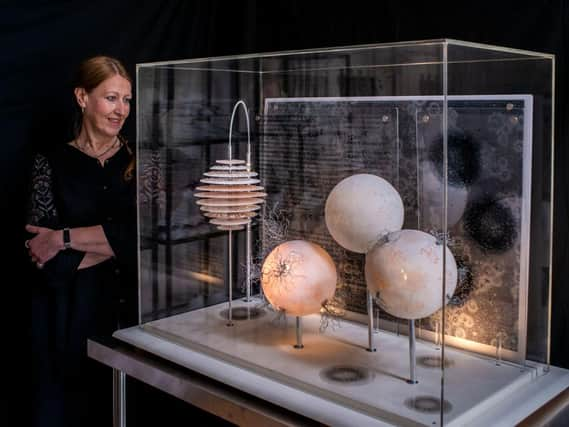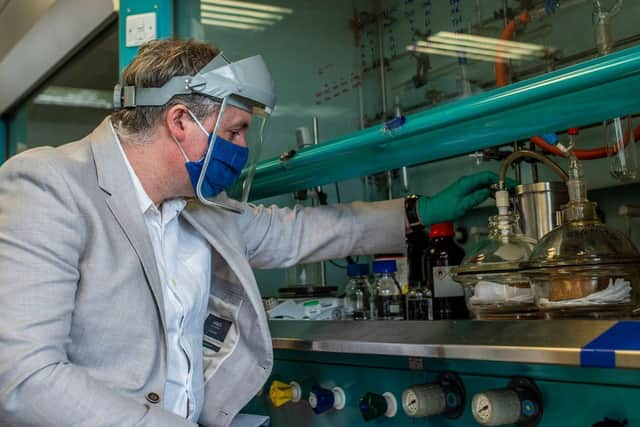Art highlights the Yorkshire pioneers developing new cancer treatments based on wasp venom


A small team of scientists based in Yorkshire are engaged in an extraordinary scientific endeavour – an attempt to develop a new type of cancer treatment by selectively damaging the surface of cancer cells.
Now their complex and ongoing work is being celebrated with a striking new artwork designed to bring their research efforts to wider public attention.
Advertisement
Hide AdAdvertisement
Hide AdSix years ago, University of Leeds researchers led by Dr Paul Beales made headlines around the world for their new insights into the way a peptide called MP1 found in the venom of a Brazilian wasp had the potential to be used in the fight against cancer. Their collaboration with São Paulo State University discovered the likely method in which the peptide produced in the toxin of a Polybia paulista wasp attacks cancerous cells.


Dr Beales said at the time that being able to create treatments which built on the way the wasp’s venom worked had the potential to create “an entirely new class of anticancer drugs”. That discovery has now led on to further research which is seeing Dr Beales and a team based at the University of Leeds work on altering the amino acid sequence of MP1 with the aim of improving the peptide’s potency and selectivity in attacking cancer cells; thereby potentially making it viable for eventual use in clinical therapies. In an advance on the 2015 study, the ongoing new research includes experiments on live cells.
As part of the funding for the project from the Engineering and Physical Sciences Research Council, money was set aside for the creation of an artwork that would initially be displayed in the atrium of the Bexley Wing of St James’s University Hospital in Leeds, before taking up permanent residence in a Clinical Research Facility within the same building.
Julie Light, a Surrey-based artist who has previously worked on similar initiatives with the likes of the Royal Society, was chosen for the commission in early 2020 and made a visit to the team’s lab that March, just before lockdown upended life as normal.
Advertisement
Hide AdAdvertisement
Hide AdSpeaking to The Yorkshire Post today over Zoom, Light and Dr Beales say while collaborative efforts on the artwork from that point were done at a distance they are both thrilled with the now-finalised results – a glass-surfaced diorama that takes the form of an imagined microscopic landscape. It is populated by abstracted, cell-like structures set into a scientific research habitat that uses materials drawn from the research itself.
Integrated lighting gradually changes through the day, drawing attention to different features of the sculpture.
Light says: “I’m very interested in and really enjoy creating artwork about scientific concepts and looking at the body and health in a way that is informed more by science than traditional ways of looking at the body.
“When I saw the call-out for the commission, I got tremendously excited. My father was a scientist and I feel very comfortable around science and find it absolutely fascinating.”
Advertisement
Hide AdAdvertisement
Hide AdDr Beales says it rapidly became clear she was a natural fit for the role and she was chosen in front of dozens of other applicants. He says the hope was an artwork would be created that would encourage discussions and engage people with the research.
“Sometimes you can lose people when you are talking about science and you can see their eyes glaze over. But when people see art, they can come to it with their own perspective and it is one of those things people feel comfortable engaging with on their own level. It then encourages them to think about the science and it can lead into very detailed conversations.”
Light says it was a particular privilege to visit Beales and his team at work, even if it was at a point when the spread of coronavirus across the UK was causing increasing alarm and worry.
“One of the really exciting things for me was to visit the labs,” she says. “It was a great opportunity to have first-hand access to things as they are developing. I spent a couple of days with Paul and the team the week before lockdown. At that point, we were all a bit cat on a hot tin roof as we didn’t know what was happening. In labs, there is already a great handwashing culture as it is so there was a lot of that and singing Happy Birthday to yourself. I took away so much from it.”
Advertisement
Hide AdAdvertisement
Hide AdLight’s diorama idea echoes the traditional dioramas often seen in natural history museums – and also had a practical purpose.
“One of the inspirations for creating a diorama was that the artwork will be located in a hospital,” she explains. “It’s important to have an artwork that can be easily cleaned, so we knew early on – even before Covid – that we wanted to create a piece that would be inside a cabinet. The idea of a diorama grew from there.”
She used a kiln to form the glass surfaces and textures that make-up the sculpture, while aspects of the team’s research were also incorporated into the backdrop.
Light had been hoping to make return visits to Leeds as her artwork progressed but most of the continued collaboration had to take place over Zoom – a situation she admits had its drawbacks. “You can’t look at things over Zoom in the same way you can in real life and you lose everything about the materiality of something,” she says. “One of the things that is really important in making 3D artwork is I like it to be tactile. I’m really happy for people to touch my work.”
Advertisement
Hide AdAdvertisement
Hide AdAs in so many walks of life, the challenges caused by Covid did not end at a just a greater reliance on Zoom calls.
The three-and-a-half year research project is currently due to end in March 2022 but because their lab was closed for six months due to the pandemic, Dr Beales says they are likely to apply for an extension. And while it was originally envisioned that the artwork could be in place in the hospital atrium in early autumn last year, that has not proved possible to date due to Covid-related restrictions.
In the meantime, it is hoped that before the work is on physical display at the hospital, it will be possible to show it online through the creation of a dedicated web page.
Dr Beales adds: “Everyone has been very impressed by the beauty of the final artwork but also the complexity and depth of the final piece. It has also struck me how scientific Julie’s approach has been at points in creating the artwork, for example experiments with different glass surfaces to mimic the textures of distinct domains formed within cell membranes.
Advertisement
Hide AdAdvertisement
Hide Ad“While we often think of art and science as two very different and apposed disciplines, in fact there are many parallels in the ways we think and work that show the gap is not as broad as many might think.
“Having the curiosity and creativity of someone like Julie around the project has been of benefit to us all in helping us view the science from broader perspectives than we would normally do.”
Artwork
The creation of the artwork has been down to collaboration and Dr Paul Beales says teamwork is even more important when it comes to the research itself.
“I’m leading the project but in the lab there are two postdocs and one PhD student doing the real research,” he says.
Advertisement
Hide AdAdvertisement
Hide AdDr Arindam Pramanik, Dr Andrew Booth and Dagmara Kobza-Mroczkowska are those conducting the work, which is being supervised by Dr Beales, from the School of Chemistry, Dr
Thomas Hughes from the Faculty of Medicine and Dr Simon Connell from the School of Physics and Astronomy.
They are also working with external collaborators from Durham, Teesside and York universities on the project.
Comment Guidelines
National World encourages reader discussion on our stories. User feedback, insights and back-and-forth exchanges add a rich layer of context to reporting. Please review our Community Guidelines before commenting.